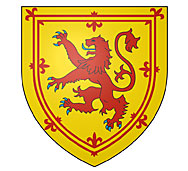Eclectic - Lion on Shield
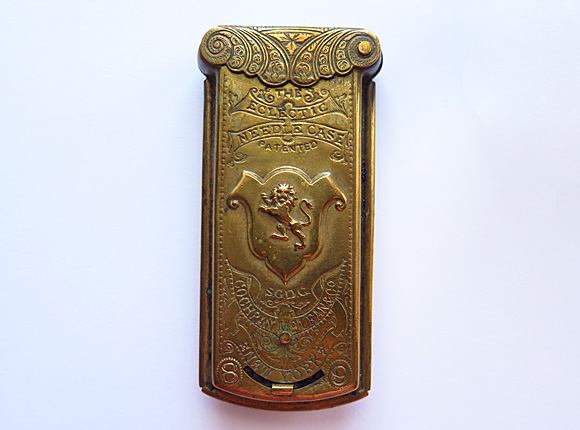
Needle Case

UK Patent 1868-3517 drawing
Design Details
Needle Case Type: |
Quadruple |
Patent/Registered to: |
William Avery, Redditch Needle Manufacturer and Albert Fenton of the same place, Machinist |
Patent/Design Representation #: |
Mechanical Patent: #3517 |
Patent/Design Registration Date: |
November 19, 1868 |
Location of Patent/Design Registration: |
British Library - Business and Intellectual Property Centre – London |
Reference #: |
1868-3517, Figures 7-10 |
Dimensions: |
3.3 x 7 |
Material: |
Brass |
Name Variations: |
Cochran, McLean & Co - New York |
Other Variations: |
See other Quadruples |
US Patent |
US 1870-98904 |
Additional Photographs
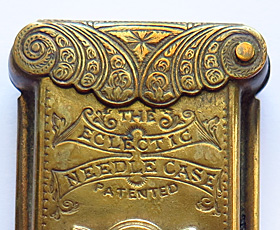
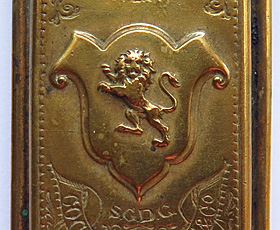
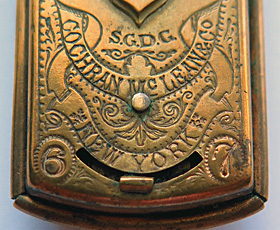
Detail views
Facts
A shield with a lion is often found on a family crest or coat of arms and symbolizes bravery, valor, strength, and royalty, because the lion is
considered the king of beasts. A rampant lion is usually depicted in profile standing erect with its front paws raised, however, it is
occasionally found with the head turned facing the viewer as it challenging the observer. According to several heraldry websites this pose,
which is pictured below, is known as “Lion Rampant Guardant” and also represents prudence. The company whose name appears on this needle case,
Cochran, McLean & Co., may have selected this symbol to represent their firm because they considered themselves a strong company that exercised
good judgment or common sense which is the definition of prudence.

Lion Rampant Guardant
History
A coat of arms is a shield with symbols and figures that represent a person, family, group or other organization. Although the ancient
Romans had shields with special insignia on them, it wasn’t until the Medieval Period that coats of arms became common. In the 12th century
they were used basically by feudal lords and knights as a way of identifying groups on the battlefield. However by the 13th century their use
spread to the European aristocracy where the family crest was inherited from one generation to the next. Within a few centuries the use of
coats of arms extended to civic organizations such as towns, cities, regions, universities, religious groups and the like. The Royal Coat of
Arms of the United Kingdom is pictured below.

Miscellaneous
Instituting the use of surnames was another way to identify individuals or related groups. Before record keeping began, most people had
only one name such as John, however as the population increased it became necessary to distinguish between individuals with the same name. The
problem was solved by adding descriptive information based on one of the following characteristic: patronymic (named after a parent), occupational
(based on the person occupation), geographic (based on the place where the person was from) or a nickname based on a physical attribute. As a
result John became John Hunter, John Erickson, John Glasgow or John Cameron (means hook nose in Gaelic).
Cochran is a version of the surname Cochrane which originally described an area known as the "Lowlands of Cochrane", located in the parish of
Paisley, near Glasgow in Scotland. The surname McLean is also Scottish however it is an Anglicized form of the Gaelic Mac Gille Eathain, a
patronymic name meaning the “son of the servant of St. John”. Cochran, McLean & Co may have selected the lion to represent their firm
because of their Scottish ancestors, since the coat of arms of Scotland, illustrated below, contains a rampant lion.
